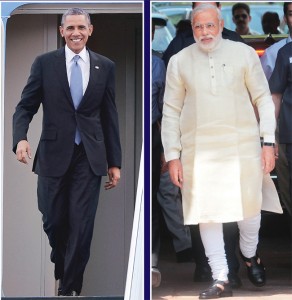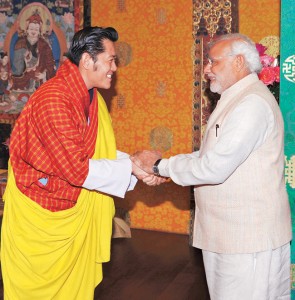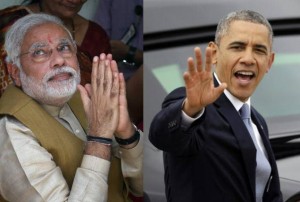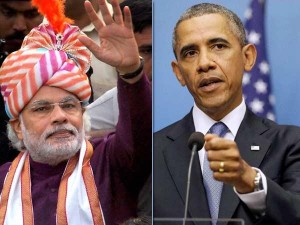It is America calling for Prime Minister Narendra Modi. In Washington and New York top policy makers and think tank wallahs are saying that a grand red carpet awaits team Modi when he visits Washington for his first summit meeting with the US President Barack Obama in September.
The reason the US is so positive about Modi is that they see in him a leader who they can do business with, deliver on the promises and take tough decisions. The failure of the UPA in not getting the nuclear liability law passed in the Parliament shook the faith of the US policy makers, and India went out of the Presidential radar. The idea now, is to bring back the focus on India through a grand visit by Modi.
Insiders say that the visit is being planned as a stand alone one and India’s Ambassador to the US, S. Jaishankar was in recently in New Delhi to talk to senior leaders. While US Under Secretary Nisha Biswal was also in New Delhi recently to do some ground work, Secretary of State John Kerry is expected to soon sit for a quick round of strategic dialogue with his Indian counterpart Sushma Swaraj, which will provide a fresh impetus to Indo-US relationship.
 An informed senate insider says that there is already efforts are being made to ensure that the Prime Minister of the world’s largest democracy is heard not only by the Indian ‘caucus’ but also gets to address the joint session of the US Congress and reach out to Americans and highlight his vision of a strong Indo-US relationship.
An informed senate insider says that there is already efforts are being made to ensure that the Prime Minister of the world’s largest democracy is heard not only by the Indian ‘caucus’ but also gets to address the joint session of the US Congress and reach out to Americans and highlight his vision of a strong Indo-US relationship.
The strategic pandits in Washington are also particularly upbeat about, apart from Modi, is run Jaitley donning the hat of the Finance and Defence Minister, as both have proven credentials of being progressive reformers who can implement big ideas.
Richard (Rick) Rossow, the smartest of the pack and the Wadhwani chair of Indo-US studies at the Centre for Strategic and International Studies, says that the US is looking to get back its love affair with India back on track. Ask him the expectations in Washington are and he replies, “Getting better nuclear liability, removing FDI caps on e-commerce, strengthening the defence relationship and signing the high-level bilateral investment protection treaty, will bring the momentum back to the relationship.”
Another important point, which is also echoed by many corporate leaders and trade bodies, is reminding the BJP of its own manifesto. “Jaitley had said that the government will end tax terrorism and send a strong message to investors. I think it will be a huge step forward,” Rossow adds.
Many in New Delhi will agree that cases like the Vodafone tax issue sent out the wrong messages to foreign investors. This community will be watching the Modi visit very closely and seeing what efforts is he taking to now make India more attractive as an investment destination.
Indian Americans, are also looking forward to the visit, and many expect that it will overcome current irritants like the Devyani Khobragade affair which had brought some dents in the strategic relationship. “Indian Americans are looking forward to meeting him as he is a strong decisive leader…the diaspora is looking forward to his visit,” said Sanjay Puri Chairman, of the US-India political action committee. Asked as to what he wanted as the takeaway from the Mod visit, Puri said, “The Obama administration should simplify export of natural gas to India and fast track free trade agreement to expand energy and defence cooperation.”
But as Washington prepares its laundry list, it is important that it addresses India’s concerns. Terrorism coming from Pakistan will be the major issue here. Consular issues, such as the providing more visas for Indian professionals, ensuring a level playing field for Indian companies in the US are some of the other matters likely to be discussed between Prime Minister Modi and the US President.
For Obama administration it is now or never. The window of opportunity is fast slipping away, as the upcoming polls in November, may see the Republicans wrestling control of the Senate. The administration, thus, needs to roll out enough bipartisan strands so the Indo-US relationship can be suitably Modi-fied to get back on track as soon as possible.
Building bridges closer home
At the heart of Prime Minister Narendra Modi’s diplomatic policy lies a renewed focus on India’s neighbours. The PM wants to allay fears India will be a big bully in the future. Modi has already signalled he will strengthen ties with the neighbours by receiving the SAARC leaders at his swearing in ceremony. While Bhutan was chosen by the Prime Minister as his first pit stop on his diplomatic journey because of being a special friend, it was also to signal to the Bhutanese leadership that India will be a genuine friend and will continue to value Thimphu’s partnership.
 Against all odds, Bhutan’s present King Jigme Khesar Namgyel Wangchuck has steered the India relationship as his country’s top focus and the elected government in Thimphu has maintained that policy. It was important that Modi creates a rapport with the Bhutanese leadership which will also send the message of friendship to the other neighbours.
Against all odds, Bhutan’s present King Jigme Khesar Namgyel Wangchuck has steered the India relationship as his country’s top focus and the elected government in Thimphu has maintained that policy. It was important that Modi creates a rapport with the Bhutanese leadership which will also send the message of friendship to the other neighbours.
Bhutan has helped India keep tabs on north eastern insurgent groups. This visit will also send a message to neighbours like China which has nurtured ambitions of strategic inroads to Bhutan and put enormous pressure on the Bhutanese government to open a diplomatic mission in Thimphu.
New NSA set to revamp security
Former IB director Ajit Doval is the new NSA for Team Modi.He was the deft negotiator at Kandahar during the hijack of IC 814 aircraft in December 2009 and now he is Prime Minister Narendra Modi’s choice for the National Security Advisor. Former Director of Intelligence Bureau and IPS officer, Ajit Doval, knows his turf well. An expert on counter terrorism, he is an insider who has already enthused the security apparatus that is looking forward to some out-of-the-box ideas in the national security apparatus.
While Doval will primarily focus on the immediate neighbourhood, he also has a vast network of contacts both within the police hierarchy and in the strategic domain which should go a long way in ensuring that the agencies are able to focus on the task of combating terrorism more effectively with quick decision making and reduced red-tape.
– Team Modi has hit the ground running. Defence and Finance Minister Arun Jaitley might have his hands full, managing both portfolios but so far has been doing an excellent job heading both the departments. So when former Army Chief General V.K. Singh tweeted against the choice of General Suhag as the new Army Chief, he was soundly ticked off. That’s not all. In the middle of the Budget preparation, Revenue Secretary Rajiv Takru was shifted out and Fertiliser Secretary Shaktikanta Das was brought in. Das had efficiently handled the Special Economic Zones during his stint in Tamil Nadu. The message coming across is clear – the government will only value and reward those who perform. Clearly, a welcome sign.
Author: Saurabh Shukla
Source: IndiaToday


